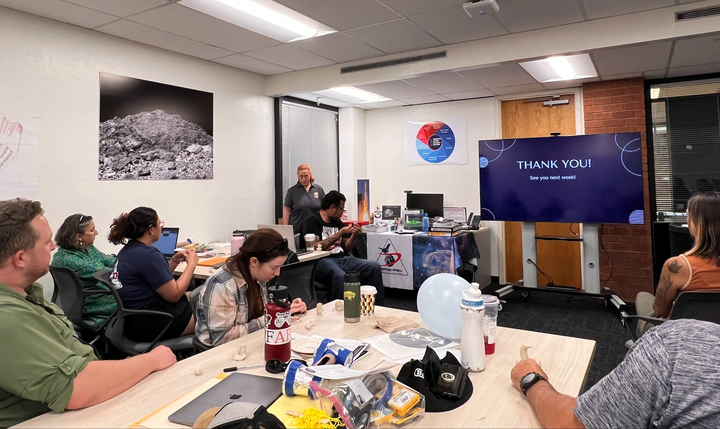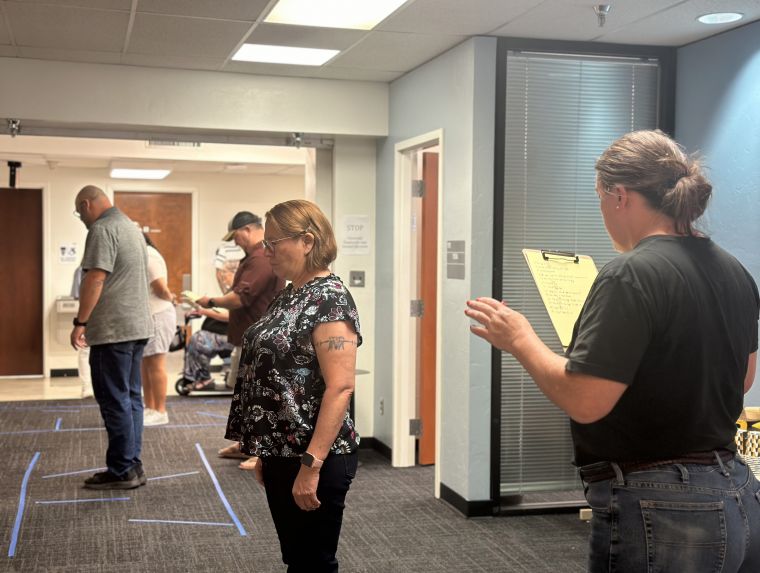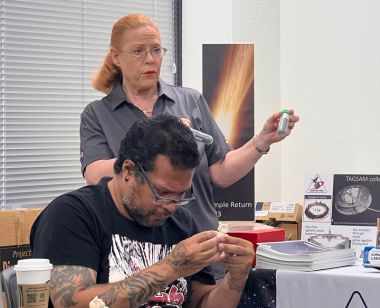Arizona Astrobiology Center, NASA champion space education for middle school teachers, students in Southern Arizona
AABC staff looks forward to hosting future NASA collaborations to further implement space education within the local community
ngs_aabc_wide_720.jpg

The Arizona Astrobiology Center (AABC) hosted NASA’s Next Gen STEM (NGS) Workshop, which brought together middle school educators from all over Southern Arizona to provide new strategies for implementing space and STEM education into their classrooms. NASA chose AABC for its mission of expanding interest in space education in Arizona and across the Southwest.
Middle school teachers filled classroom seats in the Charles P. Sonett Space Sciences Building to learn from NASA’s education specialists for three days in June. The NGS workshops are meant to inspire, equip and sustain the next generation of explorers around the country, according to Rosanna Patterson, NASA’s education program specialist.
In these workshops, Arizona educators developed their knowledge of space and engaged in aligning hands-on activities that supported pertinent NASA missions.
The goal is for these educators to implement what they have learned into their middle school curricula and get students excited about space sciences, with the hope that they may pursue STEM careers and maybe even one day contribute to NASA missions, according to Patterson.
“We hope that through our workshops we are able to provide inspiration and scaffolded guidance to our educators, so that they feel empowered to bring NASA’s activities and lessons to the community with a greater sense of self-efficacy — that they feel like, ‘I can do this,’ and that spirit translates to students,” Patterson said.
Snehalatha Rakam, a science teacher at William J. Pistor Middle School in the Tucson Unified School District (TUSD), participated in hands-on activities and learned about the Artemis missions, astronomy, the moon and Mars during the first day of workshops. With years of experience teaching science to middle schoolers, Rakam is still learning herself.
Her students complete projects each quarter of the school year and participate in the science fair, so Rakam is planning to incorporate the topics she learns into these activities so her students gain more opportunities to explore space related topics.
“I think if we take this kind of knowledge to the classroom, it will create curiosity in the students,” Rakam said. “I have experienced that they are really curious about space stuff, the stars and the solar system, so I think these will be interesting topics for my students to learn.”
NextGen_teacher_activity.jpg

Corey Knox, deputy director of AABC, explained that Arizona Science Standards and Next Generation Science Standards have certain topics and themes that are required to be taught, such as the requirement that middle school students learn about the solar system.
“Space education being highlighted in Tucson area schools would be amazing and logical, given the UA’s expertise in space sciences,” Knox said. “With Wildcat space country, I think that teachers are wanting to be space schools. Kids love it! It is part of our identity in Tucson and at the university.”
The University of Arizona has a long history of innovation in astronomy and space sciences. With its tall mountains, dark skies and low humidity, Arizona is a great location for telescope sights. These world-class observatories continue to attract preeminent researchers to the university.
“Not only do we have the engineering capabilities and world class science, but we are very dedicated to bringing that to our students and bringing that to our community,” said Dante Lauretta, director of AABC. “We are essentially training NASA’s future workforce.”
The Arizona Space Grant Consortium (AZSGC), provided funding for educator stipends to cover the cost of transportation and hotel accommodations to make this NGS workshop possible. Part of NASA’s college and fellowship project, the consortium receives NASA funding, which is then filtered into communities.
Michelle Coe, program manager of AZSGC, said that through the consortium’s capabilities to support this type of workshop, educators could impact thousands of students, securing a stronger Arizona economy in space science and STEM education.
“Space education in general also connects so many other areas of STEM, so I think it’s a really great center point to kind of branch out into all of these different fields,” Coe said. Integrating space sciences into modern classrooms helps to demonstrate real life applications of different subjects that students can explore.
ngs_aabc_vert_720.jpg

Richard Isaac Jones, science teacher at TUSD’s Mansfeld Magnet Middle School, said getting students interested in science and space early on can help them to believe that they themselves can take part in NASA’s exploration of the universe.
“There’s a possibility for these children to actually explore space, while my generation was only just at the beginning,” Jones said. “They have the real possibilities of going out there. I’m really excited for them.”
Through NASA’s NGS workshops, local middle school teachers have a chance to impact the way their students learn and think about space sciences, uniting Arizona and Southwest communities in the effort to empower their younger generation’s interest in space and scientific discovery.
Tags
Subscribe to the UArizona Impact in Action newsletter to receive featured stories and event info to connect you with UArizona's research, innovation, entrepreneurial ventures, and societal impacts.

